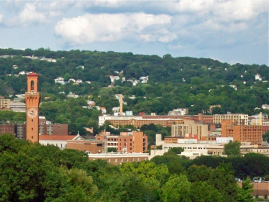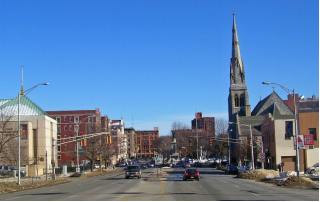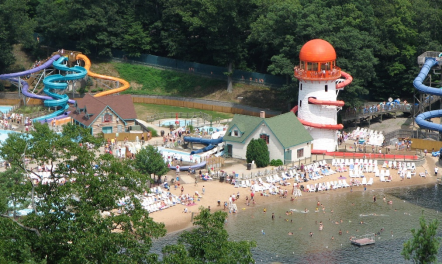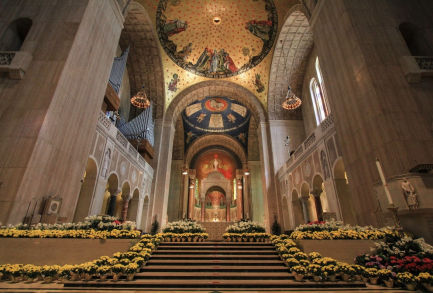Waterbury, Connecticut 作者: 来源: 发布时间:2021-07-20
I.Population and Area
₋Area
Land: 28.94 sq mi (74.97 km2)
₋Population
Total: 3,771.40/sq mi (1,456.14/km2)
Density: 110,366

II.Natural Geography
₋Waterbury (nicknamed "The Brass City") is a city in the U.S. state of Connecticut on the Naugatuck River, 33 miles (53 km) southwest of Hartford and 77 miles (124 km) northeast of New York City. Waterbury is the second-largest city in New Haven County, Connecticut. As of the 2010 census, Waterbury had a population of 110,366, making it the 10th largest city in the New York Metropolitan Area, 9th largest city in New England and the 5th largest city in Connecticut.
₋Throughout the first half of the 20th century, Waterbury had large industrial interests and was the leading center in the United States for the manufacture of brassware (including castings and finishings), as reflected in the nickname the "Brass City" and the city's motto Quid Aere Perennius? ("What Is More Lasting Than Brass?"). It was also noted for the manufacture of watches and clocks.
₋The city is along Interstate 84 (Yankee Expressway) and Route 8 and has a Metro-North railroad station with connections to Grand Central Terminal. Waterbury is also home to Post University and the regional campuses of the University of Connecticut, University of Bridgeport, Western Connecticut State University as well as Naugatuck Valley Community College.

III.GDP
₋The average salary in Waterbury, CT is $17.52. Trends in wages decreased by -2.2 percent in Q1 2020. The cost of living in Waterbury, CT is 14 percent higher than the national average. The most popular occupations in Waterbury, CT are Certified Nurse Assistant (CNA), Registered Nurse (RN), and Licensed Practical Nurse (LPN) which pay between $11.71 and $33.09 per year. The most popular employers in Waterbury, CT are St. Mary's Hospital, Waterbury Hospital, and Staywell Health Center.
₋Website: https://www.payscale.com/research/US/Location=Waterbury-CT/Salary
IV.Industrial Characteristics
₋The valley, with Waterbury the hub, was the center of the American brass industry and a capital, too, of general manufacturing for daring entrepreneurs and skilled workmen who combined to turn out a broad range of brass and related products: buttons, pins, screws, rivets, wire, coins, tokens, fasteners, hinges, kettles, watches, clocks, tableware, ammunition casings.
₋Waterbury became ''the Brass City,'' the Naugatuck Valley ''the Brass Valley.'' After World War II, the economy of Waterbury and the rest of the Naugatuck Valley began to decline. Plastics eliminated markets; operations were shuttered; single-purpose industrial companies were transformed into multinational corporations in which brass products constituted only a small part of product lines. Once brass employment in the valley numbered 50,000 people; today it is less than 5,000.
₋Website: https://www.nytimes.com/1982/09/10/nyregion/historians-explore-the-waterbury-area-s-brass-industry.html
V.Attractions
1.Lake Compounce

₋Lake Compounce is an amusement park located in Bristol and Southington, Connecticut. Opened in 1846, it is the oldest continuously operating amusement park in the United States. It spans 332 acres (134 ha), which includes a beach and a water park called Crocodile Cove included in the price of admission. The park was acquired from Kennywood Entertainment Company by Palace Entertainment, the U.S. subsidiary of Parques Reunidos. In addition to the 14th oldest wooden roller coaster in the world, Wildcat, its newer wooden roller coaster, Boulder Dash, has won the Golden Ticket Award for the #1 Wooden Coaster in the World for five consecutive years.
₋The lake's name is derived from Chief John Compound, a Mattatuck/Tunxis Native American. On December 3, 1684, his tribe signed a deed that left Compound's Lake to a group of white settlers, including John Norton, who had migrated to central Connecticut from Massachusetts. The property was left to the settlers in exchange for a small amount of money and miscellaneous items, including a large brass tea kettle. A local myth suggests that Chief Compound drowned while trying to cross the lake in the brass tea kettle.
₋ Address: 185 Enterprise Dr, Bristol, CT 06010, United States
₋Opened: 1846
₋Website: https://www.lakecompounce.com/plan-a-visit/tickets-and-passes
2. Black Rock State Park

₋Black Rock State Park is a seasonal public recreation area adjoining Mattatuck State Forest in the town of Watertown, Connecticut. The state park covers 444 acres (180 ha) and is known for its large rock face, Black Rock, that offers views of Thomaston, Watertown, and portions of Waterbury. The park is managed by the Connecticut Department of Energy and Environmental Protection.
₋The park saw its origins in 1926 with the donation of 19 parcels totaling 254 acres by the citizen's conservation group Black Rock Forest, Inc. The Civilian Conservation Corps contributed to the park's development in the 1930s.
₋ Phone: +1 860-283-8088
₋Website: https://portal.ct.gov/DEEP/State-Parks/Parks/Black-Rock-State-Park
3. Basilica of the Immaculate Conception

₋The Basilica of the Immaculate Conception is a Roman Catholic church located at 74 West Main Street in Waterbury, Connecticut.
₋Early accounts say that the first priest to visit Waterbury was one James Fitton of Hartford. He was followed by Rev. James McDermot of New Haven, who said Mass in the house of Cornelius Donnelly. McDermot was transferred to Lowell in the summer off 1837, and Waterbury became a mission station of St. Mary's in New Haven. Rev. James Smyth served the community for the next ten years. On his first arrival, Smyth thought to say Mass in the same house frequented by McDermot but was told be the tenant that the landlord had threatened eviction if he entertained anymore priests. He then said Mass at the home of Michael Neville on East Main Street. In 1845, Washington Hall, on the corner of Exchange Place and West Main Street was rented from Dr. Jesse Porter.
₋In 1847, the Catholic community purchased a former Episcopal church and sought to move it to a lot on the corner of East Main and Dublin Streets. However, on approaching the desired location, the contractor, Major D. Hill of Hartford, was convinced that he could not get the structure safely over the high ground, so Neville, acting as agent for the Catholics, purchased a second, more accessible lot. Accept for when Smyth visited Waterbury, baptisms, Marriages, and funerals took place in New Haven. Bishop Tyler of Hartford purchased a lot south of Grand Street through John Galvin for use as a burying ground.
₋In October 1847, Rev. Michael O’Neil became the first resident pastor and dedicated the parish to St. Peter. Initially O'Neil resided with the family of Michael Neville, on Dublin Street opposite the cemetery gate. In 1850, he rented a house on East Main Street from John Sandland. In December 1854, a fire broke out in the church, but managed to be extinguished by those present before it got out of control. In 1855, O'Neil was sued for trespass by the Protestant husband of a Catholic woman for administering last rites pursuant to the woman's wishes. O'Neil was fined $150 plus costs. O'Neil stated the under no circumstances would he divulge the content of the woman's confession. The judge said that it was not essential to deciding the case, but if it had been, he would have required it of the priest. This is in marked contrast to a case in New York involving Rev. Anthony Kohlmann some twenty-five years previous.
₋In July 1855, O'Neil went to East Bridgeport and was succeeded at St. Peter's by Rev. T.F. Hendricken. Hendricken hired Patrick Keely to design a new, larger church. On July 5, 1857, the parish laid the cornerstone for a new church, in the Gothic style. Built of red brick, with a tall spire, it stood on East Main Street. It was dedicated by Bishop McFarland, and renamed in honor of the Immaculate Conception, the first church in the United States to bear that title since the 1854 decree. The old church became St. Mary's school in 1863.
₋In 1869 he persuaded the Congregation of Notre Dame of Montreal to come to the parish, where they established Notre Dame Academy, a day and boarding school for girls. He also purchased land for St. Joseph's Cemetery. In 1872, Hendricken was named Bishop of Providence.
₋Since the 1990s the former Trinity Episcopal Church on Prospect St. was used as a parish center. Due to structural problems, the building was demolished in 2018. Some of the stained glass and altars from the church were removed and given to other churches in Connecticut.
₋Address: 74 W Main St, Waterbury, CT 06702, United States
₋Opened: 1928
₋Phone: +1 203-574-0017
₋Website: https://www.wtbybasilica.org/
VI.History
₋The land was originally inhabited by the Algonquin bands. According to Samuel Orcutt's history, some Puritan residents of nearby Farmington "found it expedient to purchase the same lands from different tribes, without attempting to decide between their rival claims." The original settlement of Waterbury in 1674 was in the area now known as the Town Plot section. In 1675, the turbulence of King Philip's War caused the new settlement to be vacated until the resumption of peace in 1677. A new permanent location was found across the river to the east along the Mad River. The original Native American inhabitants called the area "Matetacoke" meaning "the interval lands." Thus, the settlement's name was Anglicised to "Mattatuck" in 1673. When the settlement was admitted as the 28th town in the Connecticut Colony in 1686, the name was changed to Waterbury in reference to the numerous streams that emptied into the Naugatuck River from the hills on either side of the valley. At that time, it included all or parts of what later became the towns of Watertown, Plymouth, Wolcott, Prospect, Naugatuck, Thomaston, and Middlebury.
₋Growth was slow during Waterbury's first hundred years, the lack of arable land due to the constant flooding of the Naugatuck River in particular, discouraged many potential settlers. Furthermore, the residents suffered through a great flood in 1691 and an outbreak of disease in 1712. After a century, Waterbury's population numbered just 5,000.
₋Waterbury emerged as an early American industrial power in the early 19th century when the city began to manufacture brass, harnessing the waters of the Mad River and the Naugatuck River to power the early factories. The new brass industry attracted many immigrant laborers from all over the world, leading to an influx of diverse nationalities. Waterbury was incorporated as a city in 1853 and, as the "Brass Capital of the World", it gained a reputation for the quality and durability of its goods. Brass and copper supplied by Waterbury was notably used in Nevada's Boulder Dam and found myriad applications across the United States, as well.
₋Another famous Waterbury product of the mid-19th century was Robert H. Ingersoll's one-dollar pocket watch, five million of which were sold. After this, the clock industry became as important as Waterbury's famed brass industry. Evidence of these two important industries can still be seen in Waterbury, as numerous clocktowers and old brass factories have become landmarks of the city.
₋Also of note in Waterbury's industrial history was the production of silverware, starting in 1858 by Rogers & Brother, and in 1886 by Rogers & Hamilton. In 1893, Rogers & Brother exhibited wares at the World's Columbian Exposition in Chicago. In 1898, both companies became part of the International Silver Company, headquartered in nearby Meriden. Production continued at the R&B site until 1938. Today designs by the two companies are in the collections of the Mattatuck Museum in Waterbury, the Brooklyn Museum in New York, the Yale University Art Gallery in New Haven, and in many historical societies and museums across the United States.
₋In June 1920, labor unrest occurred in the town, with striking workers fighting with police on the street. Over 30 were arrested, mostly Lithuanians, Russians, Poles, and Italians. The strikers numbered some 15,000, with most being employed at Scovill, Chase Rolling Mill, and Chase Metal Works. One striker was shot to death by police.
₋At its peak during World War II, 10,000 people worked at the Scovill Manufacturing Co, later sold to Century Brass. The city's metal manufacturing mills (Scovill Manufacturing, Anaconda American Brass, and Chase Brass & Copper were the largest) occupied more than 2 million square feet (180,000 m2) and more than 90 buildings.
VII.Other Information
₋Government
₋Waterbury has about 52,000 registered voters, of whom about 24,000 are Democrats. There are about 7,800 registered Republicans and the balance are largely unaffiliated, with a smattering belonging to minor parties.
₋John S. Monagan, who was a prolific author in addition to his political responsibilities, served as Waterbury's mayor from 1943 to 1948. He also served as its district's congressional representative from 1959 to 1973. George Harlamon, a member of the Waterbury Hall of Fame, was the city's 40th mayor. He served from 1969 to 1970 during a period of racial tension. The city is known for its hard-nosed political culture compared locally to Cook County, Illinois, close elections, and a number of scandals.
₋Waterbury's scandalous past dates back to 1940, when Mayor T. Frank Hayes and 22 others were convicted of conspiracy to defraud the City of Waterbury. Hayes received a 10–15 year sentence and served six years. Ironically, the massive corruption scheme was exposed with the help of then comptroller Sherwood Rowland, grandfather of Gov. John G. Rowland, who was convicted on corruption charges in 2004. What appeared to have been a defeat for Hayes was not really a victory for Pape, and the stage was set for further corruption in Waterbury in the second half of the 20th century. Waterbury was in serious financial straits due to years of mismanagement, resulting in the city's finances being taken over by the State of Connecticut. The State Oversight Board oversaw city business for several years and have since left following consecutive years of balanced budgets. The successors to Philip Giordano, former acting mayor Sam Caligiuri (2001) and former mayor Michael Jarjura (2001–2011) managed the city without major controversy since 2001. Democrat Neil O'Leary was elected the 46th Mayor of Waterbury on November 9, 2011. As of July 2012, the mayor of Waterbury earns an annual salary of $119,306.
₋In 1939, Pape backed an attempt to install council-manager government and single-transferable-vote elections. The local Republican Party and Connecticut General Assembly also supported this measure. New York Mayor Fiorello H. La Guardia helped campaign for its passage, having backed similar reforms in his own city in 1936.
₋A number of presidential candidates have campaigned in Waterbury due to its pivotal role in statewide elections. The most famous was the election eve visit on the Green by John F. Kennedy in 1960. Forty thousand people waited until 3 am on the Green to greet Kennedy on Sunday, November 6, 1960. Sen. Kennedy spoke to them from the balcony of the Roger Smith Hotel (now called the Elton). Pierre Salinger later said it was the greatest night of the campaign. In September 1984 Ronald Reagan held a huge noontime election rally at the same location. In July 2006 former president Bill Clinton made a campaign appearance at the Palace Theatre for Senator Joe Lieberman during his campaign for re-election to the U.S. Senate. Shortly after the Democratic primary, Tom Swan, campaign manager for Lieberman's opponent Ned Lamont, described Waterbury as a place where "the forces of slime meet the forces of evil," after a large majority of the town's voters backed Lieberman. Swan claimed he was referring to former mayor Philip A. Giordano and former governor John G. Rowland.
₋Governor John G. Rowland served ten months in a federal prison until February 10, 2006. He was released from federal prison with the stipulation that he serve four months house arrest with an electronic ankle bracelet monitor until June 2006.
₋In January 2008 Waterbury Mayor Michael Jarjura announced that he would hire Rowland as an economic development advisor for the city. Rowland began work in February that year receiving an annual salary of $95,000 as the city's economic development coordinator funded in conjunction with the Greater Waterbury Chamber of Commerce.
₋In 2011, the Board of Aldermen voted to eliminate funding the city's portion of his salary and in November 2011 Rowland stated he would give up his position when his contract expired thus ending his quasi-city employment.
₋Later that year, following his victory over then Mayor Jarjura, new mayor Neil O'Leary created the position of Economic Development Director as part of his new administration, removing the duties from the Chamber of Commerce and bringing them directly into City Hall, making Economic Development a cornerstone of his administration. Ron Pugliese was hired as the first director to hold the position.
VIII.Contact Information
₋Government
Type: Mayor–council
žMayor: Neil O'Leary (D)
₋City Hall
₋Address:
235 Grand Street
Waterbury, CT 06702
₋Phone: (203) 597-3444
₋Fax: (203) 574-6804
₋Website: https://www.waterburyct.org/content/9569/9605/
